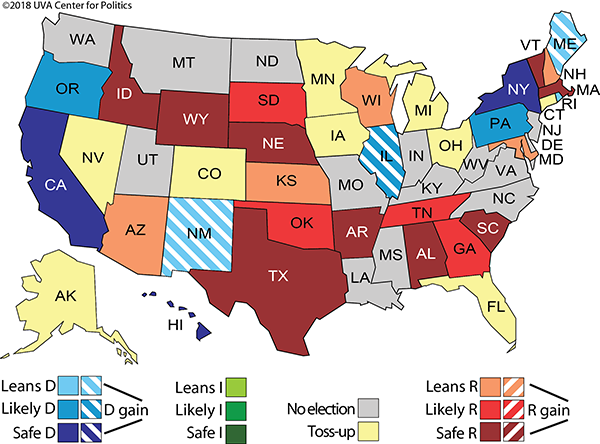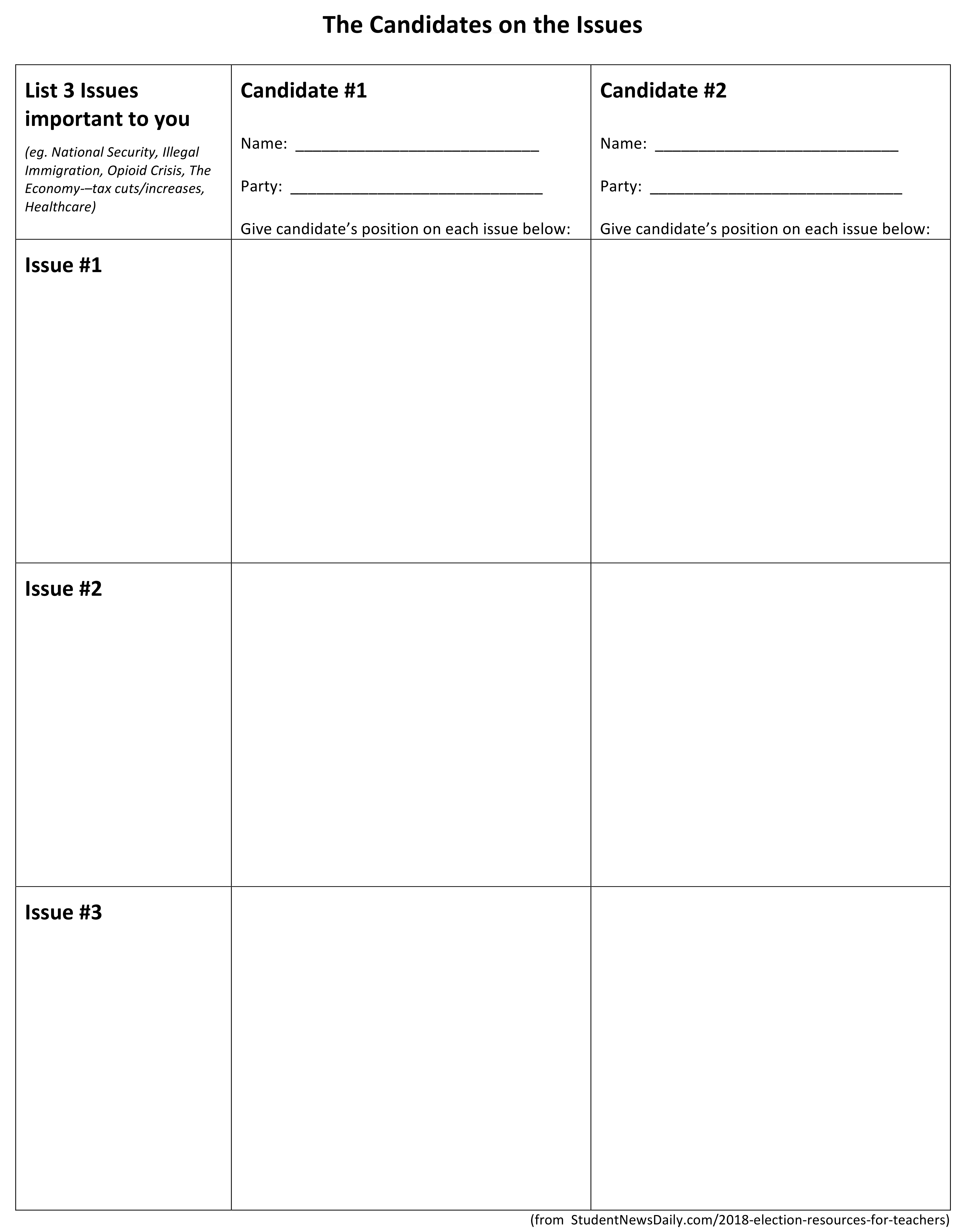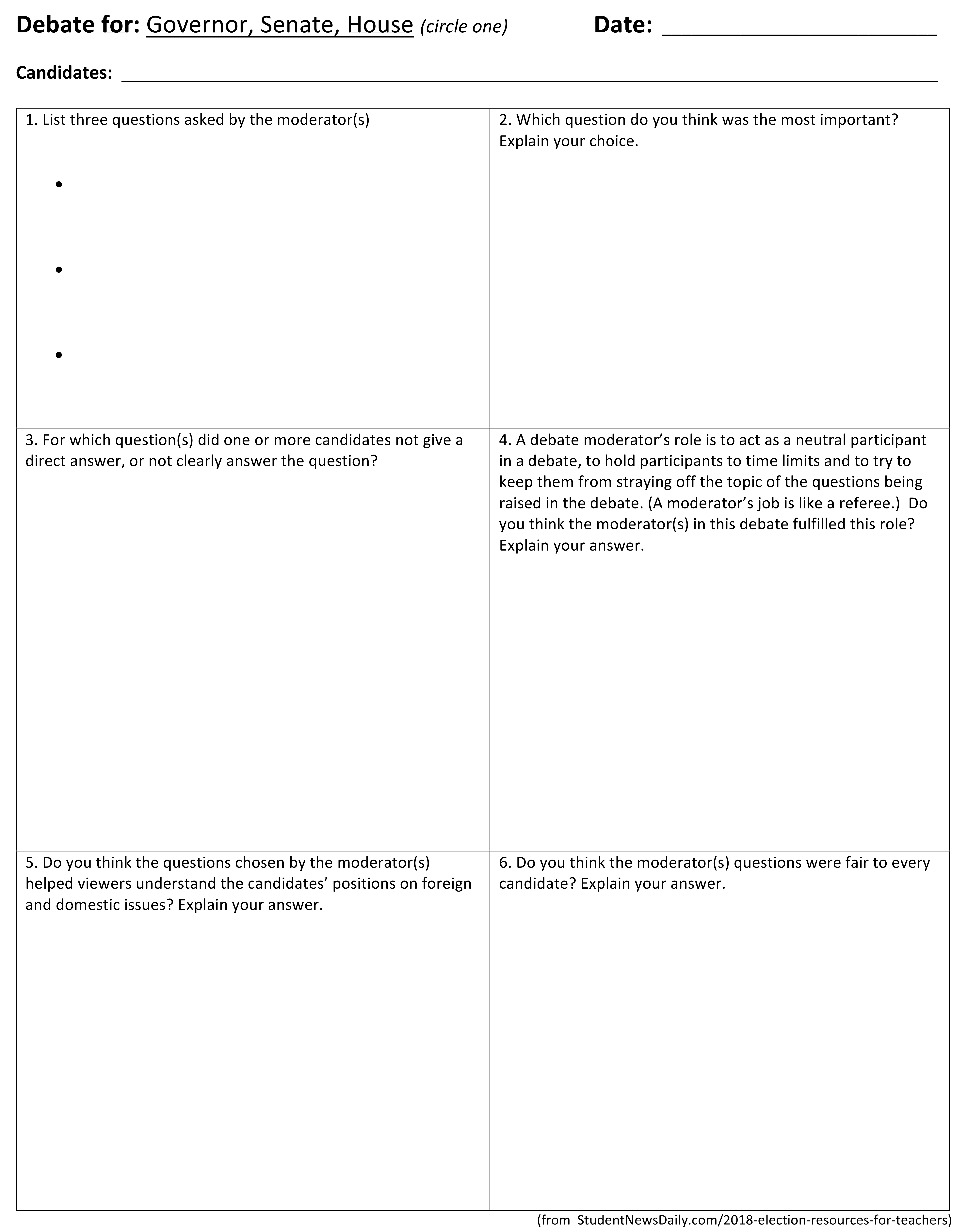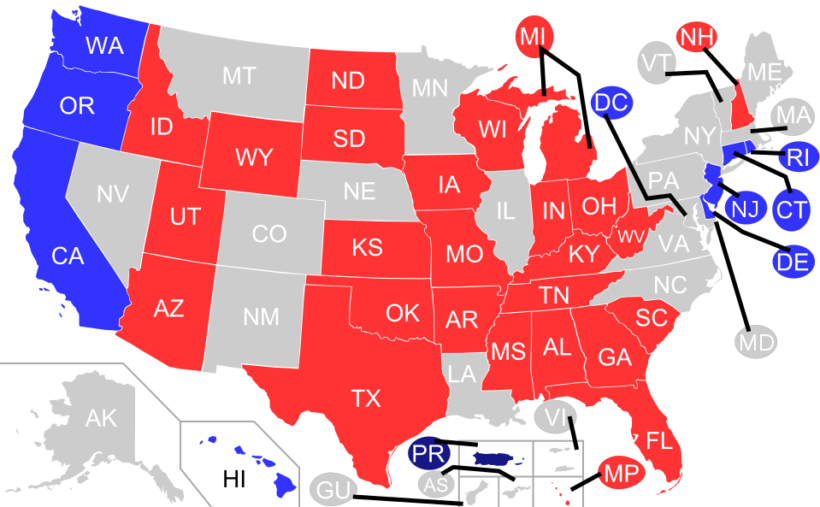“The ignorance of one voter in a democracy impairs the security of all.”
~ President John F. Kennedy
TABLE OF CONTENTS (Revised 10/31/18)
- Overview
- US Senators/Representatives
- Governors
- The Candidates on the Issues (includes student worksheet)
- Debates (includes student worksheet)
- Conservative v. Liberal Beliefs
- State Election Websites
- Ballot Measures
- 2018 Election maps, polls, editorials and news articles
- Cartoons
- Party Platforms
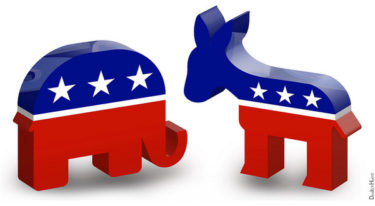
2018 General Elections
The 2018 general elections will be held on Tuesday, November 6, 2018. This is a midterm election year. During these midterm elections, all 435 seats in the U.S. House of Representatives and one-third of the 100 seats in the U.S. Senate will be contested. Midterm elections are those elections that fall in even-numbered years that do not feature a presidential election.
In addition to the Congressional races, 39 state and territorial governorships and 46 state legislatures (except Louisiana, Mississippi, New Jersey and Virginia), four territorial legislatures and numerous state and local races will take place.
In addition, numerous ballot measures, mayoral races, and a variety of other local offices are on the ballot.
Wikipedia notes:
- Midterm elections are sometimes regarded as a referendum on the sitting president’s and/or incumbent party’s performance.
- The party of the incumbent president tends to lose ground during midterm elections: over the past 21 midterm elections, the President’s party has lost an average 30 seats in the House, and an average 4 seats in the Senate; moreover, in only two of those has the President’s party gained seats in both houses (in the second term of Presidents Bill Clinton and George W. Bush).
- Midterm elections usually generate lower voter turnout than presidential elections. Approximately 50-60% of voters turn out for presidential elections, while approximately 40% turn out for the midterms. Follow results to see how this year compares.
QUESTIONS:
1. What percent of voters turned out for the 2018 midterms?
2. In the 2018 midterms, did President Trump’s party (Republicans) win or lose seats in the Senate? in the House? How many in each? Why do you think this is so?
For links to all races by state (federal and local), go to Ballotpedia and click on your state. You will find information on all races on your state page.
U.S. SENATORS/REPRESENTATIVES:
SENATORS:
- Did you know that a third of the Senate is up for election every two years? — read about it at: Wikipedia.
- Republicans currently hold the Senate majority with 51 seats. Democrats hold 47 seats; in addition the 2 independent senators in Congress (Senator Angus King of Maine and Democratic Socialist Bernie Sanders of Vermont) both caucus with the Democrats.
- In the 2018 elections, 33 of the 100 seats will be contested. (In addition, 2 states are holding special elections for Senators who resigned in early 2018 – Minnesota Democrat Al Franken due to inappropriate conduct against women and Mississippi Republican Thad Cochran due to health issues).
- For 2018 Senate election information, go to: realclearpolitics.com/elections/2018
- Note: The U.S. has held direct elections of U.S. Senators for over 100 years. Do you know which amendment established this policy? (see wikipedia for the answer)
REPRESENTATIVES:
- Elections will be held to elect representatives from all 435 congressional districts across each of the 50 U.S. states. Non-voting delegates from the District of Columbia and the five inhabited U.S. territories will also be elected. (Six of these seats are to replace vacancies.)
- The House is currently composed of 226 Republicans and 193 Democrats.
- For 2018 House election information: realclearpolitics.com/elections/2018
To find out how members of Congress have voted on any proposed legislation, visit govtrack.us [NOTE: Don’t enter your address, use 2nd box to just choose your state] . GovTrack says it “helps ordinary citizens find and track bills in the U.S. Congress and understand their representatives’ legislative record.”
QUESTION:
Discuss how the majority party in both houses affects proposed legislation and also the federal government’s budget, spending and taxation.
See Wikipedia for a brief explanation.
GOVERNORS:
- Gubernatorial elections will be held in 36 states and 3 territories in 2018.
- Currently, there are 33 Republican governors, 16 Democrats, and one independent (Alaska).
- Additionally, there are 2 Republicans (Guam and Northern Mariana Islands), 1 Democrat (American Samoa) and 1 independent (U.S. Virgin Islands) holding offices in the U.S. territories; furthermore Ricky Rosselló (Puerto Rico) is registered with the New Progressive Party but nationally affiliated as a Democrat. The Mayor of the District of Columbia, Muriel Bowser, is a Democrat.
- For information on current governors, see the National Governors Association website: nga.org
- For 2018 election information: realclearpolitics.com/elections/2018
QUESTION:
Name the candidates running for office in your state. Include party affiliation and office each candidate is running for.
The map below from UVA Center for Politics predicts possible election results for governors as of July 2018:
THE CANDIDATES ON THE ISSUES:
Visit the campaign websites and YouTube pages for candidates running for office in your state/county/city to hear where they stand on the issues.
(To find the candidates’ pages, search for: “‘name of candidate’ youtube page”).
Answer the questions below or complete the pdf worksheet:
QUESTIONS:
1. List 3 issues you believe are important to consider in this election.
2. What does each candidate say they would do to address each issue? (What are his/her solutions?)
3. What actions has each taken (legislation) to support or undermine his/her position on each issue?Consider this: Some people vote for a candidate based on the person’s age, sex, race or religion. Some vote for a candidate because he/she is an interesting or dynamic speaker, is attractive, or looks like a leader. Before you are eligible to vote, decide that you will vote for a candidate based on his/her positions on the issues.
NOTE: The U.S. has a two-party system, which distinguishes American government from most other democracies. Most Western democracies, particularly those in Europe, have multiparty elections and parliaments, but the American government traditionally has had a two-party system. Since the Civil War the two parties have been the Republican Party and the Democratic Party.
From time to time, third parties have gained traction with the electorate, most recently the Reform Party, led by Ross Perot, who won 19% of the popular vote in the 1992 presidential election. Third parties can sometimes push the major parties to consider their position on a specific issue (generally when they believe the party is not taking a strong enough stand, or is taking a moderate position on the issue). Few third-party candidates hold elected office at the state and national level. There are dozens of “third parties” in the U.S. including the Constitution Party (conservative), the Green Party (liberal) and the Libertarian Party (in general socially liberal, fiscally conservative).
DEBATES:
The central focus of a debate is to provide voters with information they need to measure the suitability of the candidates for office.
Watch the debates for your state’s senator, representatives and governor. Pay attention to the questions the moderator asks. View the “Debate” pdf worksheet to answer the questions below:
QUESTIONS:
1. List three questions asked by the moderator.2. Which question do you think was the most important? Explain your choice.
3. For which question(s) did one or more candidates not give a direct answer, or not clearly answer the question?
4. A debate moderator’s role is to act as a neutral participant in a debate, to hold participants to time limits and to try to keep them from straying off the topic of the questions being raised in the debate. (A moderator’s job is to act like a referee.) Do you think the moderator in this debate fulfilled this role? Explain your answer.
5. Do you think the questions chosen by the moderator helped viewers understand the candidates’ positions on the issues important to voters? Explain your answer.
6. Who was the moderator for this debate? Do you think the moderator’s questions were fair to every candidate? Explain your answer.
CHALLENGE: Are any candidates holding debates for your state or local offices?
Attend a local debate between the candidates. Pay attention to the questions the moderator asks.
Did the moderator’s questions cause each candidate to clearly explain his position on each issue? Explain your answer. OR, use the same worksheet above and answer those questions.
CONSERVATIVE vs. LIBERAL BELIEFS:
Check out StudentNewsDaily’s “Conservative vs. Liberal Beliefs” chart. [NOTE: This is a general overview of the conservative and liberal positions on the issues.]
QUESTION:
Read through the chart. For each issue, state which position best represents your beliefs and explain why.
STATE ELECTION WEBSITES:
Links to all 50 states’ Election Board websites are provided here. (Note: Many states include information and/or links to candidates’ websites.)
QUESTIONS:
Visit your state’s official election webpage.
1. What requirements does a prospective candidate need to meet to have his/her name on the ballot in your state?
2. What type of information would you like to see on your state’s elections page? Send an email to your state’s Secretary of State with your suggestion. Identify yourself with your name, school and city. Be clear, concise and polite. (Find contact information for your Secretary of State on your state’s election page, or for a list of all state Secretaries, go to: nass.org)
CHALLENGE QUESTION: What issues are important to voters in your state in the upcoming election? How do the opposing candidates stand on the issues?
For links to all races by state (federal and local), go to ballotpedia.org, scroll down to the map and click on your state, or go to
Ballotpedia’s 2018 State Legislative Elections page.
NOTE: A state government trifecta is a term to describe when the state house, the state senate, and the office of the governor are each controlled by the same political party. As of August 2018, 34 states have trifectas – Republicans hold 26 trifectas; Democrats hold 8. (For details, see a Ballotpedia article.)
The map below from Wikipedia shows party control of state Legislatures and Governorships as of October 11, 2017:
BLUE = Full Democratic control RED = Full Republican control GRAY = Democratic / Republican split control
QUESTION:
In the 2018 midterms, did the Republicans or Democrats lose trifectas in their any states? Name the states. Why do you think this is so?
BALLOT MEASURES:
Anything that appears on a ballot other than a candidate running for office is called a ballot measure. Ballot measures are broken down into two distinct categories – initiatives (or propositions) and referendums.
- Initiative – Citizens, collecting signatures on a petition, place advisory questions, memorials, statutes (laws) or constitutional amendments on the ballot for the citizens to adopt or reject. “Initiative” refers to newly drafted legislation submitted directly to a popular vote as an alternative to adoption by a state legislature. Twenty-four states have the initiative process.
- Referendum – In many of the same states the citizens have the referendum process – the ability to reject laws or amendments proposed or already passed by the state legislature.
The terms above are all forms of direct democracy practiced by various states. In a direct democracy, all citizens, without the intermediary of elected or appointed officials, can participate in making public decisions. Ballot measures are a form of direct democracy practiced by many states in the U.S.
Visit the Ballotpedia website for:
- A map that shows the type of ballot measures each state allows – ballotpedia.org/Ballot_measure
- A list of current 2018 state and local ballot measures by state – ballotpedia.org/2018_ballot_measures
- A list of all previous ballot measures by state – ballotpedia.org/List_of_ballot_measures_by_state
QUESTIONS:
Does your state practice direct democracy through the ballot measure process?
If so, what initiatives or referendums are on your state’s ballot in the upcoming election?
If there are ballot measures in your state, how would you cast your vote on each question?
2018 ELECTION MAPS, POLLS and EDITORIALS:
- Politico
- RealClearPolitics
- C-Span (as the election draws closer, you will find more information here)
Election articles/editorials:
News articles from StudentNewsDaily:
- What you need to know before the midterm election 2018
- Judge blocks 2018 New Hampshire law requiring new voters show proof of residency
- Judge rules Georgia can still use electronic voting machines despite concerns over hacking
- Many 2018 battleground U.S. House districts see strong 2017 income growth
- Judge denies request to allow ‘ballot selfies’
- Virginia Ends Use of Touch-Screen Voting Machines
- Using an app to vote? West Virginia 1st state to test the technology
- U.S. Supreme Court strikes down Minnesota dress code for voters
Editorials posted previously at StudentNewsDaily:
- How Tampering with Search Engines Could Swing an Election
- 5 Reasons Local Elections Are More Important Than You Think
- Don’t Vote if You Didn’t Do Your Homework
CARTOONS:
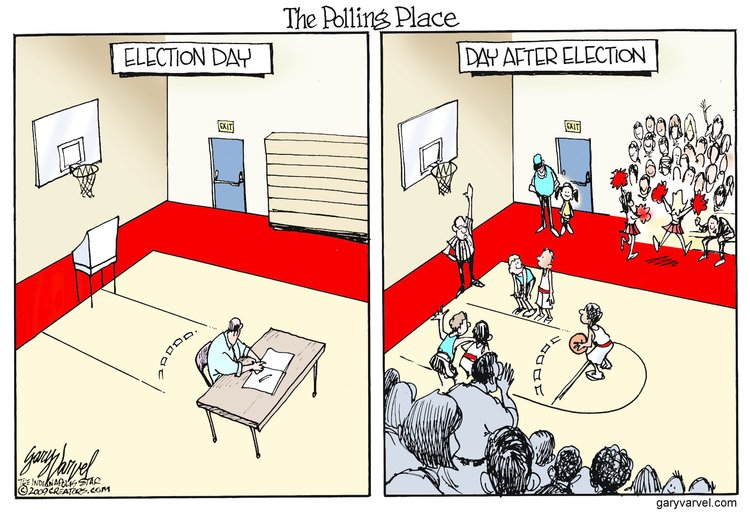
PARTY PLATFORMS:
A National Platform is the official statement of a political party’s position on a wide variety of issues. Each issue category included in the Platform is a “plank.” A new Platform is adopted every four years by both the Democratic and Republican parties and is generally approved during the party’s national convention.
2016 Republican Party Platform (compare to 2012 and 2008 platforms)
2016 Democratic Party Platform (compare to 2012 and 2008 platforms) – (NOTE: 2012 Platform was passed during convention on 9/4/12 and amended to add mention of God and Jerusalem on 9/5/12.)
View all current and previous party platforms at The American Presidency Project.
(also see 2018 Libertarian Party platform, Constitution Party Platform and the Green Party platform)
QUESTIONS:
How specific or detailed is each party on its positions on the issues?
1. Choose 3 issues and summarize each party’s position on those issues.
2. For each issue, explain if you believe the party was specific or vague in stating its position. Why do you think this is so?
3. What role does each party believe the government should take on each issue? (What type of government action and/or legislation, if any, does each party support?)
4. For these issues, how does each party’s position line up with your own?
(This page last updated 10/31/18. Information compiled from various sources including Ballotpedia and Wikipedia.)
